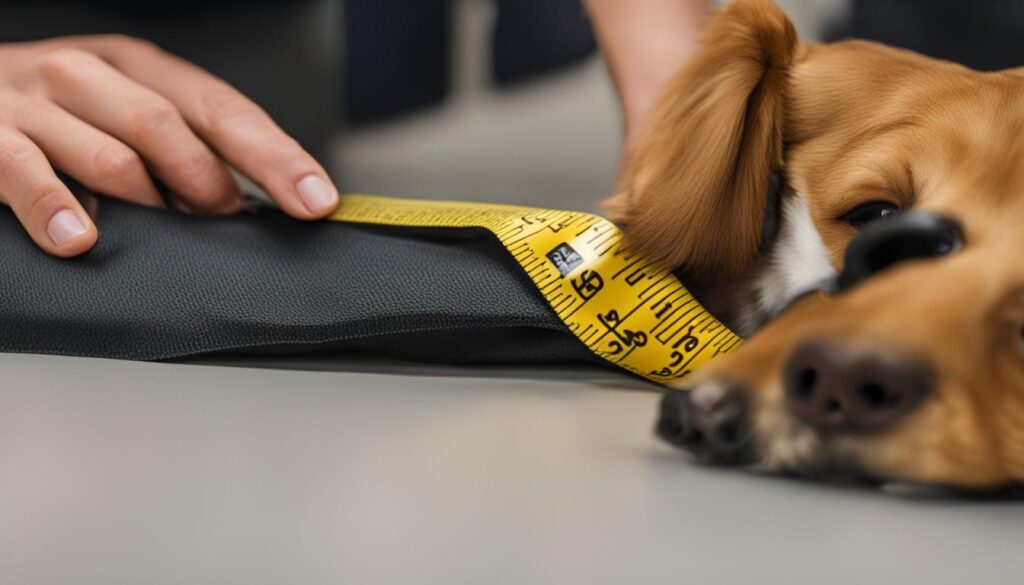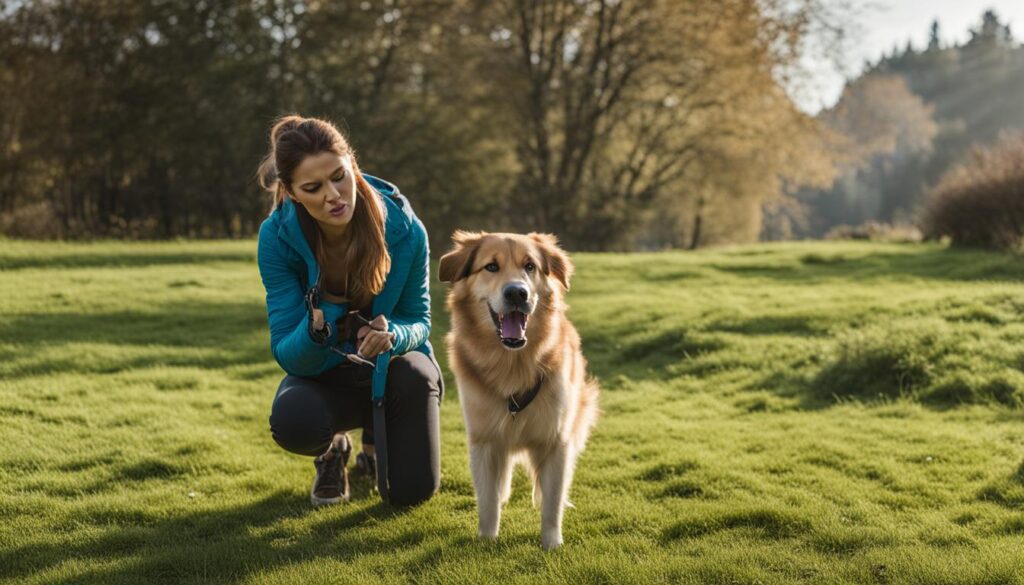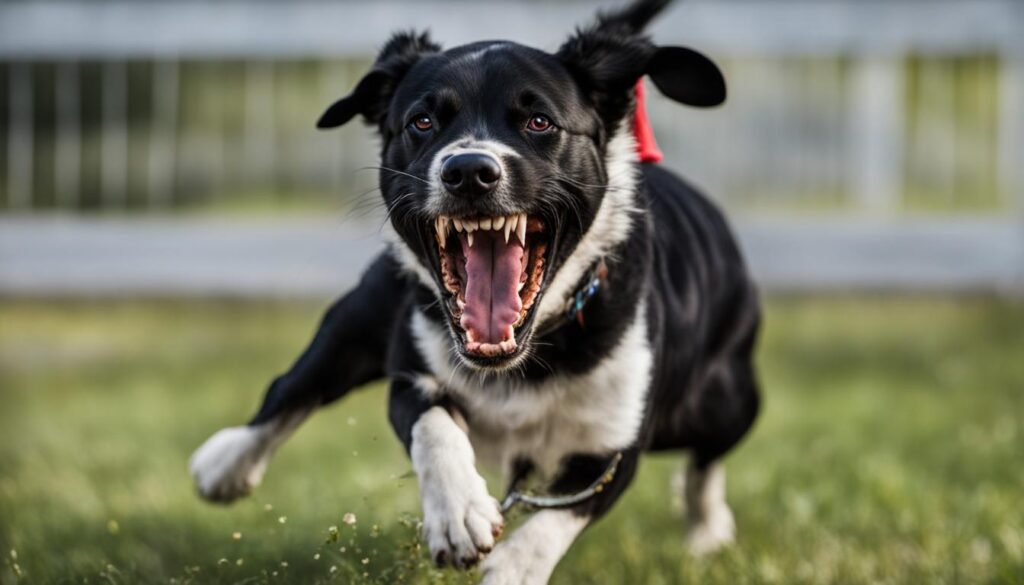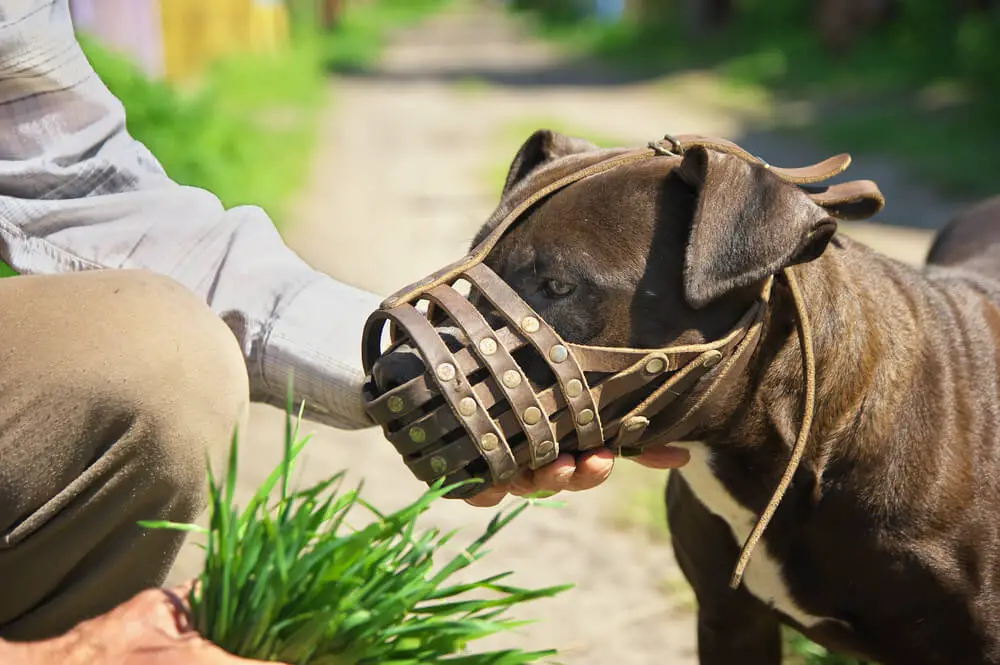Choosing the right aggressive dog muzzle is crucial for maintaining safety without compromising your dog’s comfort. A well-fitted muzzle can provide a sense of confidence for owners when handling snarky or reactive dogs, particularly in situations where biting may occur, such as during a visit to the vet or when your fur buddy is in pain. It is important to keep in mind that safe dog muzzles should be considered as a helpful tool but not as the solution to addressing the underlying aggression issues in your canine companion.
Veterinary behaviourists recommend basket muzzles made of wire or high-quality plastic over other muzzle types, as they do not hinder your dog’s ability to pant, drink, or take treats, thus minimizing fear and anxiety. Brands such as Jafco and Baskerville Ultra have gained a reputation on Amazon for their quality and effectiveness when it comes to effective muzzles for biting.
Proper muzzle usage includes ensuring a good fit to allow for efficient panting (especially in warm temperatures), and considering the duration of use in training situations with basket-type muzzles. In this article, we’ll explore the key factors to keep in mind when choosing the best muzzle for aggressive dogs and effective ways to introduce your furry friend to their new safety gear.
Key Takeaways
- Choose muzzles made of wire or high-quality plastic as they are safe and humane.
- Consider brands such as Jafco and Baskerville Ultra for quality and effectiveness.
- Proper muzzle fit is essential for allowing your dog to pant and drink.
- Muzzles should be used as a helpful tool, not as a standalone solution for aggression.
- Introduce your dog to the muzzle through gradual and rewarding exposure.
Understanding the Importance of a Properly Fitting Muzzle
A properly fitted muzzle is crucial for the comfort and safety of your dog, as well as the effectiveness of managing aggressive behaviors. This section will delve into muzzle types and their specific uses, essential features for comfort and safety, and the role of muzzles in behavior management.

Muzzle Types and Their Specific Uses
There are several types of dog muzzles, each with its specific purpose and function:
- Occlusion muzzles: Ideal for short-term use during vet visits or grooming, these muzzles should not be used during strenuous events or in heat as they may cause overheating.
- Leather muzzles: Commonly used for protection training, leather muzzles tend to be durable and comfortable but may fare poorly in wet conditions.
- Basket muzzles: Preferred by behaviorists for training aggressive behaviors, these muzzles allow ample airflow and jaw movement, reducing the risk of overheating or escalating fear and anxiety.
When selecting a muzzle, make sure it fits properly to prevent discomfort and ensure effectiveness. Allow enough room for panting, ensure a snug neck strap, and find one that allows treat delivery for positive reinforcement.
Essential Features for Comfort and Safety
Key elements to consider when choosing a comfortable and secure dog muzzle include:
- Proper ventilation and airflow
- Ability to pant, drink, and vomit
- Lightweight materials for minimal intrusion
- A secure fit to prevent removal
- Treat delivery during training
Different muzzles offer varying levels of bite-proofness and robustness, which could impact their suitability based on the canine’s behavior and needs.
The Role of Muzzles in Behavior Management
Muzzles play a vital role in dog behavior management by serving as a preventive tool in avoiding bites and ensuring safe interaction during behavior modification training. Basket-type muzzles are especially suitable for this purpose due to their design, which enables natural behaviors such as panting and positive reinforcement through treats.
“Muzzles should not be viewed as a standalone solution but part of a broader behavior management strategy.”
Consulting a veterinary behaviorist to diagnose issues beyond the scope of a muzzle, such as excessive barking, is advised. Remember, muzzles are not intended to cure aggression but rather to prevent harm while addressing the underlying behaviors through appropriate training and behavior modification techniques.
Top Picks for Durable and Reliable Muzzles
When evaluating muzzles for longevity and reliability, well-reviewed options like Jafco, Dean and Tyler, and Baskerville Ultra stand out. To help you make an informed decision, we’ve compiled a list of the top-rated dog muzzles, considering factors like durability, comfort, and ease of use. Let’s take a closer look at these high-quality muzzles and their features.
| Brand | Design | Key Features |
|---|---|---|
| Jafco | Plastic/Resin Basket Muzzle |
|
| Dean and Tyler | Wire Basket Muzzle |
|
| Baskerville Ultra | Thermoplastic Rubber Basket Muzzle |
|
Jafco muzzles are revered for their quality and are frequently employed by veterinary institutions and trainers alike. With their sturdy design and adequate airflow, these muzzles are an excellent choice for ensuring both safety and comfort.
Made from high-quality wire, Dean and Tyler’s muzzles are renowned for their durability. They offer a spacious basket design, allowing for larger breeds to wear the muzzle comfortably, as well as a rubber-coated version for colder climates.
Baskerville Ultra Muzzle provides a lighter alternative designed for dogs of various sizes. Its smooth, thermoplastic rubber construction ensures good airflow and comfort. However, it is essential to pay attention to potential skin irritation and choose the right size for your dog.
Ultimately, the trustworthiness of these reliable muzzles for dogs can be further ascertained by the product reviews on trusted retailers such as Amazon, reflecting customer satisfaction and product effectiveness over time.
Remember, finding the best durable dog muzzle depends on your dog’s specific needs, intended use, and size, so always consult with a professional before making a decision.
Accessibility to high-quality, reliable muzzles is critical for the safety and well-being of not only your dog but also those around them. By researching top-rated dog muzzles and analyzing helpful muzzle reviews, you can make an informed choice for a comfortable and secure muzzle for your dog.
How to Introduce Your Aggressive Dog to a Muzzle
Introducing a muzzle to an aggressive dog might seem challenging. Still, with the right approach and positive muzzle training techniques, you can ease your dog into accepting and feeling comfortable wearing a muzzle. The key is creating positive associations with the muzzle and gradually desensitising your dog to its presence and use.

Step-by-Step Positive Muzzle Training Techniques
Follow these steps to introduce your dog to a muzzle using positive reinforcement muzzle training:
- Introduce the muzzle: Let your dog investigate the muzzle by placing it near them, allowing them to sniff and explore it. Reward your dog with treats and praise for showing interest in the muzzle.
- Create positive associations: Start feeding your dog treats through the muzzle’s opening to create a positive association with the muzzle. Practice this several times for a few days to reinforce the connection.
- Encourage voluntary muzzle wearing: Hold the muzzle with one hand and a treat with the other. Allow your dog to voluntarily place their nose into the muzzle to get the pleasure. Praise and reward them each time they do this.
- Gradually increase the duration: Once your dog is comfortable inserting their nose into the muzzle, gradually extend the time it wears the muzzle. Start with a few seconds and slowly increase the duration, always providing treats and praise throughout the process.
- Secure the muzzle: When your dog is comfortable wearing the muzzle for short periods, begin to practice securing the straps. Initially, only connect the straps for a few seconds before releasing them, and then reward your dog. Gradually increase the time the straps are secured.
- Practice in different environments: To help your dog feel comfortable in various situations, practice muzzle training in other settings, such as at home, on walks, or during visits to the vet.
Patience and consistency are key when introducing your dog to a muzzle. Take your time, and consistently reward positive behaviour throughout the training process.
Following these step-by-step positive muzzle training techniques, you can successfully introduce your dog to a muzzle without causing stress or anxiety. Additionally, incorporating varying usage periods during the training ensures that your dog remains calm and content, resulting in a safe and positive experience for you and your dog.
Addressing Common Myths About Muzzles and Aggression
Several myths and misconceptions prevail regarding dog muzzles, leading to unnecessary stigma and confusion. In this section, we will address these myths and provide facts to understand better the role of muzzles in managing aggressive behaviour in dogs.

- Myth: Muzzles are solely used for punishment and are cruel.
- Fact: Muzzles are preventive tools to protect dogs and people from harm. When used responsibly, they provide a safe way to manage aggressive behaviours while addressing the underlying issues with proper training and behaviour modification techniques.
- Myth: Muzzles can increase the level of aggression in a dog.
- Fact: While an ill-fitting or improperly used muzzle can cause discomfort and stress, a properly fitted and introduced muzzle should not exacerbate aggression. They can help reduce the risk of harmful incidents, fostering a safer environment that supports behaviour management efforts.
- Myth: A muzzle will “cure” a dog’s aggression, making training and behaviour modification unnecessary.
- Fact: Muzzles are not a substitute for training and behaviour modification. They serve as a valuable tool to prevent harm as you work to address the root causes of your dog’s aggression through professional training and appropriate behaviour management techniques.
In conclusion, understanding the facts about muzzles and their purpose in aggression management is essential to promote responsible usage and positive outcomes for dogs and their owners. Remember, it’s crucial to view muzzles as a tool in your behaviour management arsenal and not as a standalone solution.
Choosing the Right Muzzle Material for Your Dog's Needs
Deciding on the suitable muzzle material is crucial and hinges on various factors, including the purpose and the dog’s demeanour. Leather muzzles, plastic muzzles, and metal basket muzzles each present their unique advantages and potential drawbacks, which need to be carefully considered before making a decision. We will explore the pros and cons of each material to help you choose the perfect muzzle for your dog’s needs.
Pros and Cons of Leather, Plastic, and Metal Muzzles
| Material | Pros | Cons |
|---|---|---|
| Leather |
|
|
| Plastic |
|
|
| Metal |
|
|
Some muzzles can be modified for treatment delivery, greatly enhancing their utility in training contexts. For example, certain metal basket muzzles allow easy access for treat delivery, while others may require some modification to accommodate treats.
When selecting a muzzle material for your dog, please consider their specific needs and the intended purpose of the muzzle. Each material has benefits and drawbacks, so choose the one that will provide the best balance of comfort, safety, and functionality for your dog’s needs.
In summary, dog muzzle materials play a significant role in finding the right fit for your aggressive or reactive dog. Leather dog muzzles offer durability and comfort at the cost of maintenance and potential issues in wet conditions. Plastic muzzles are lightweight and flexible but can become brittle or break under extreme pressure. Metal basket muzzles provide optimal airflow and security for aggressive dogs but can be heavy and potentially harmful if not fitted properly. Assess your dog’s specific needs and your intended purpose for the muzzle to make the ideal choice.
Conclusion
In conclusion, selecting the best muzzle for an aggressive dog entails a thoughtful evaluation of your dog’s specific needs and circumstances. This includes assessing any underlying behaviour issues and considering the environment in which your dog will be wearing the muzzle. By choosing a dog muzzle that fits well and provides essential benefits like panting and ventilation, you can ensure that both your dog and those around them are safe.
Finally, staying informed about the pros and cons of different muzzle materials and consulting trusted resources, like online retailers and expert advice, can be invaluable in making an informed decision. By doing so, you will not only benefit your dog’s well-being but also ensure a safer
Frequently Asked Questions (FAQs)
What factors should I consider when selecting a muzzle for my aggressive dog?
When selecting a muzzle for your aggressive dog, consider features such as proper ventilation for panting and airflow, mouth movement for drinking and treat delivery, size for a secure fit, and the muzzle’s material and durability for appropriate bite prevention and strength. Also, consider a lightweight muzzle to minimize the risk of injury.
How can I positively introduce my aggressive dog to a muzzle?
You can introduce your aggressive dog to a muzzle through gradual and rewarding exposure. Allow your dog to sniff the muzzle and show interest, followed by brief periods of wearing the muzzle coupled with treats and praise. It is crucial to desensitize and condition your dog to wear a muzzle, ensuring it becomes a stress-free and enjoyable experience through positive reinforcement.
How do I choose the right muzzle material for my dog's needs?
To choose the suitable muzzle material, consider your dog’s behaviour and needs, as well as the purpose of the muzzle. Leather muzzles offer durability and some comfort but require maintenance and are unsuitable for water exposure. Plastic muzzles provide flexibility and are lighter, while wire basket muzzles, despite being heavier, offer optimal airflow and security for aggressive or reactive dogs. Each material has its unique set of advantages and potential drawbacks to consider.
What are the main types of muzzles for aggressive dogs?
The main types of muzzles for aggressive dogs include basket muzzles, which come in wire, high-quality plastic, or rubber; occlusion muzzles, designed for short-term use like vet visits; and leather muzzles, typically used in protection training. Basket muzzles are the most recommended type for aggressive dogs due to their comfort, ventilation, and allowing natural behaviours such as panting and treat delivery.

